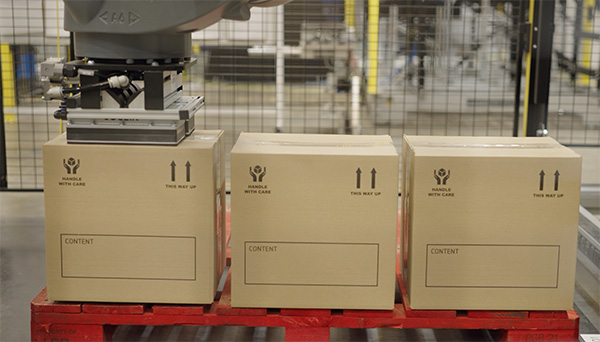Manual palletising and automated palletising are two different methods of loading goods onto pallets for storage or shipment. Here’s a comparison between the two:
- Labour Requirements:
- Manual Palletising: Requires human labour for stacking goods onto pallets. This can be physically demanding and time-consuming, especially for heavy or bulky items, and can often lead to repetitive strain injuries occurring.
- Automated Palletising: Requires minimal human intervention. Robots or machines handle the palletising process, reducing the need for manual labour. This can result in cost savings on labour over time, and will typically have a very fast payback where goods are being loaded onto pallets all day every day.
- Speed and Efficiency:
- Manual Palletising: Relatively slower compared to automated palletising. Human workers may take more time to stack items neatly and securely onto pallets, and palletising will stop when workers take their breaks.
- Automated Palletising: Generally faster and more efficient. Robots or machines can palletise goods quickly and consistently, leading to higher throughput and productivity, with most systems being able to run 24/7.
- Accuracy and Consistency:
- Manual Palletising: Susceptible to human error. Stacking may vary in consistency, leading to potential stability issues during transport.
- Automated Palletising: Offers high precision and consistency. Robots can stack items uniformly, reducing the risk of pallet instability and product damage.
- Cost Considerations:
- Manual Palletising: Initial setup costs are lower since it primarily involves labour. However, long-term labour costs may accumulate, and there may be occasions where you have to hire in extra staff to palletise; such as during busy seasons or when staff are off sick.
- Automated Palletising: Higher initial investment due to the cost of machinery and installation. However, over time, savings can be realised through increased efficiency and reduced labour costs. Leasing an automated palletising system is an alternative that is often cheaper than the cost of labour.
- Flexibility and Adaptability:
- Manual Palletising: Offers greater flexibility in handling various types of products and irregular loads. Human workers can adapt quickly to changes in packaging or stacking requirements. This is especially so where you have irregular shaped products or are stacking mixed product onto pallets.
- Automated Palletising: Initially, setup may require specific programming for each product type, unless you install an easy program palletising system which can be programmed in minutes by your staff.
- Safety:
- Manual Palletising: Involves physical labour, which can lead to injuries or strain, especially when handling heavy items. This in turn can lead to staff absences which then has an impact on output.
- Automated Palletising: A lot safer for workers as they are not directly involved in the heavy lifting or repetitive tasks. However, proper training, safety protocols and maintenance are necessary to ensure safe operation of the machinery.
The decision between manual palletising and automated palletising ultimately depends on factors specific to your business, such as your budget, the volume and type of goods you handle, labour availability, safety considerations, and long-term goals. Here are some guidelines to help you make the decision:
- Volume and Throughput: If you have high volumes of goods that need to be palletised quickly and consistently, automated palletising might be the better option due to its speed and efficiency.
- Labour Costs and Availability: Consider the cost of labour and whether you have enough workers available for manual palletising. Do you have to hire in extra labour during peak seasons? If labour costs are high or if you’re experiencing challenges in finding and retaining workers, automated palletising could be more cost-effective in the long run.
- Initial Investment: Assess your budget and determine whether you can afford the initial investment required for automated palletising equipment. While automated systems typically have higher upfront costs, they can lead to long-term savings in labour and increased efficiency. Many palletising systems are also available to lease, which removes the need for an initial investment, making it a far more viable investment for some companies.
- Product Characteristics: Evaluate the characteristics of the products you handle. If your products are uniform in size and shaped, automated palletising may be easier to implement. However, if you handle a wide variety of irregular shaped products, manual palletising might offer more flexibility.
- Safety Considerations: Take into account the safety of your workers. If manual palletising poses a high risk of injuries due to heavy lifting or repetitive tasks, investing in automated palletising can improve workplace safety.
- Future Growth: Consider your long-term goals and growth projections. If you anticipate increasing your production volume over time, automated palletising may better accommodate scalability and future expansion. Choosing a palletising system that can be modified and added to as you grow is a good investment.
Ultimately, it’s essential to carefully consider all of these different factors to determine the best solution for your specific needs and circumstances. Conducting a cost-benefit analysis comparing the upfront costs, ongoing operational expenses, and potential benefits of each option can help inform your decision-making process. You may find these downloadable calculators helpful:
- https://www.granta-automation.co.uk/automation-project-payback-calculator
- https://www.granta-automation.co.uk/news/how-to-define-the-value-of-intangible-benefits/
If you would like to discuss your specific application then feel free to contact us on 01223 499488 or helpline@granta-automation.co.uk.









Warning: Undefined variable $aria_req in /var/www/granta-automation.co.uk/news/wp-content/themes/twentyten/comments.php on line 81
Warning: Undefined variable $aria_req in /var/www/granta-automation.co.uk/news/wp-content/themes/twentyten/comments.php on line 86